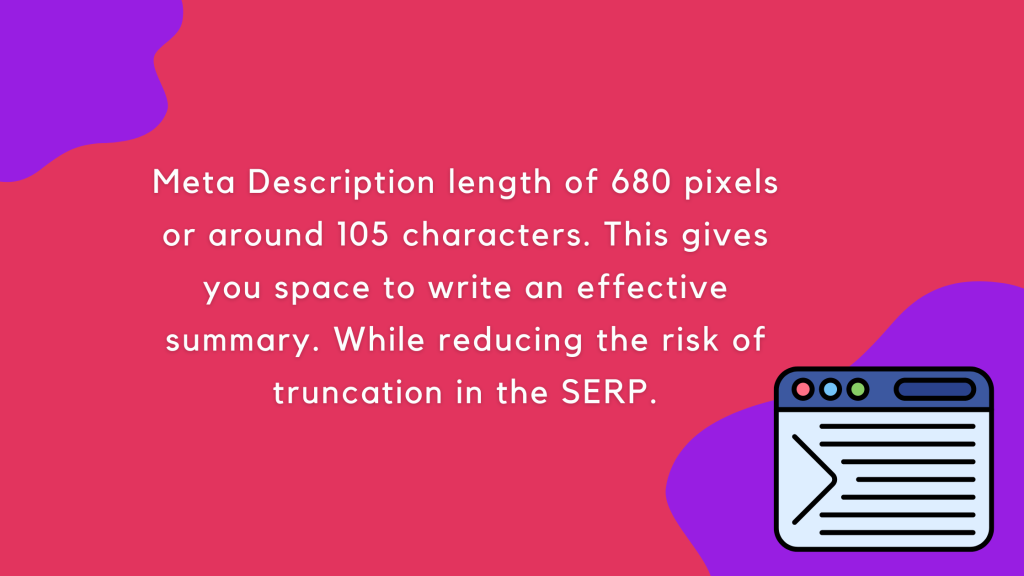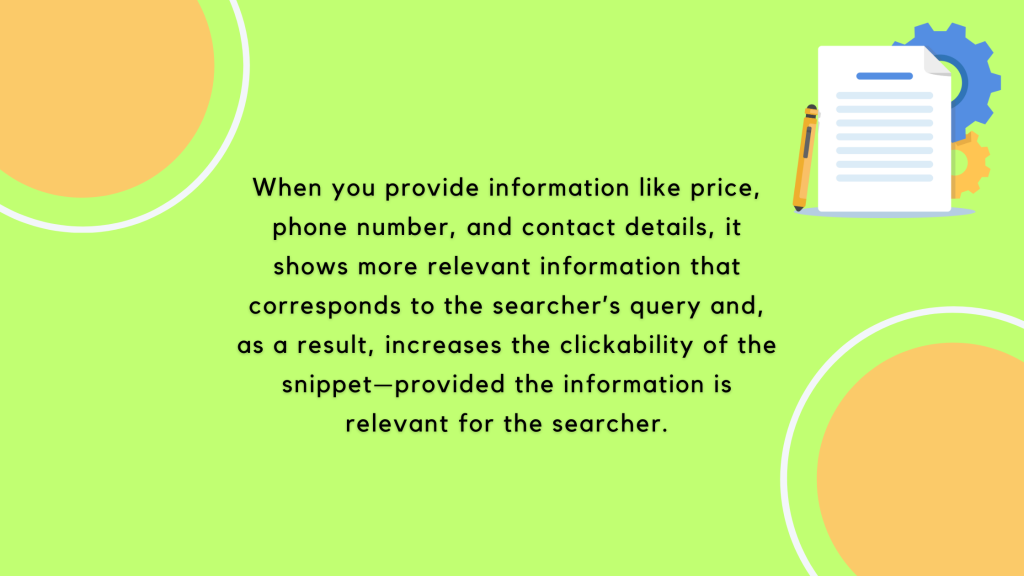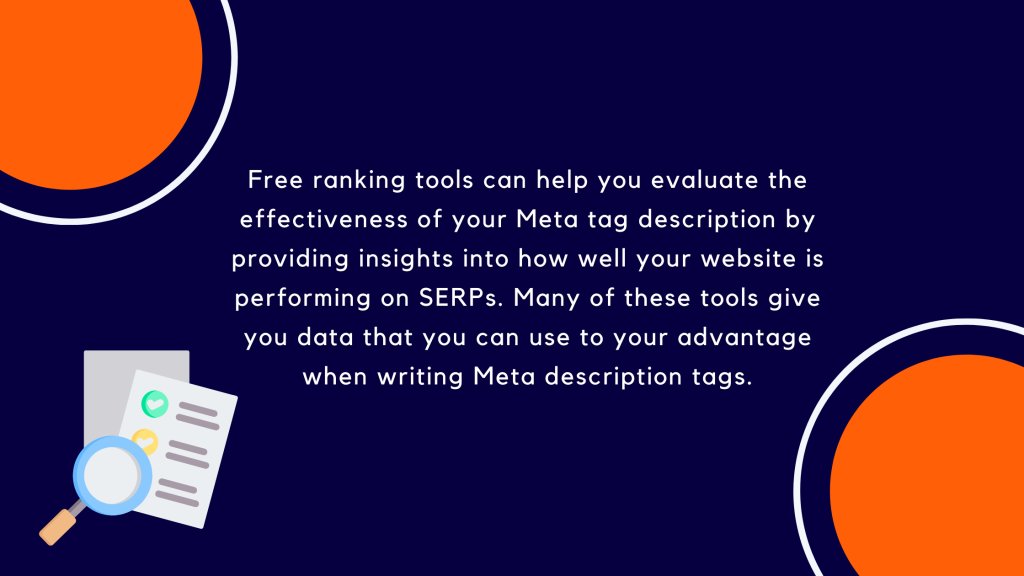Meta Description Tags: A Key Element of On-Page Optimization
What is a Meta description tag?
A Meta description is an HTML tag that, like the Meta title, provides a very brief summary of a page for the benefit of search engines and users.The primary purpose of a Meta description is to let users know what the page is about and encourage them to click through to your site from the SERP.
This snippet of text usually appears in the SERP under your headline. However, sometimes Google may pull a snippet of text from the main content of the page.

How do I find your Web Page’s Meta description?
Meta descriptions are displayed by search engines in the search results below your Title. It is a critical element, as your prospects will use your description to decide whether or not to click on your listing.
A compelling description will help you get more clicks, which in turn will help improve your rankings. However, you cannot see your Meta Description by simply visiting your web page. Meta descriptions are not displayed by browsers, and only search engines can read and use the information. Here is the process for finding your Meta description of your web page:
Visit the web page: Open the web page for which you need to find the Meta description in your web browser.
Right-click and choose “view page source.” Any web page’s Meta description is easily accessible by right-clicking anywhere in the page (except for images and links) and choosing “view source” or “view page source.”
Search for the Meta description tag: In the source code of the page, look for the <meta> tag with the name description. Meta description is usually located within the header section of the HTML code.
Your description tag looks like this in the HTML code:
<Meta name=”description” content=”

The text within the Content attribute is the Meta description of a web page. It provides a brief summary of a web page and is often used by search engines to display snippets in search results.
When a searcher types in a query that your page ranks for, this information displays as a text snippet on the SERP. It should include a quick explanation of what users might expect to find on your website.
One should keep in mind that some websites might use dynamic content generation to create HTML code. In such cases, it can be a bit complex to find the exact Meta descriptions. However, more static web pages have a description directly in the source code.
Why Meta Tag descriptions are relevant in SEO?
Google had mentioned that the Meta description tag is used to generate a description of a page that will be featured in the snippet, but it is not used to rank pages. However, as the Meta description increases the click-through rate of the SERP snippet, it has an indirect impact on the rankings of a page.

Meta description tag is the descriptive text in snippets displayed right under the title. They are used for generating snippets that tell searchers about your web page and help them to decide if they further click it and visit the page. An effective snippet persuades more people to click your link, eventually increasing your click-through rate. It also helps to increase brand awareness.
Google often take the text for the snippet description of the HTML meta description tag itself. However, if it turns out to be uninformative, Google tend to use any content on the page to generate a snippet.
It is always recommended to use the data-no snippet HTML attribute to prevent Google from pulling text from your page to generate a description. You can also use the max-snippet: [number] tag to limit the length of the snippet. Refer to Google’s official guide to learn more about these tags.
How do I create the perfect Meta description tag?
Meta descriptions can attract the attention of potential users in SERPs, so you can’t simply overlook them. Each page must have a unique and separate Meta description tag. It enables you to put forward the text you want to display in a snippet description.
If you fail to create a unique and informative description, search engines will take any piece of content from your website as per their logic of relevance to the search query and use it in the snippet instead. That’s why it is important to write effective Meta descriptions. Let’s look at some best practices for writing Meta descriptions for a website.
1. Length of a Meta description
If the Meta description tag goes over 155 characters, Google will cut it down, so there’s no point in creating extensively long description tags that searchers won’t like to read. However, the exact number of characters displayed in a sniper depends on various factors, such as

• User’s device: Desktops have more space than mobiles.
• The width of the characters (some characters use more pixels than others)
• The user’s search query (As words take up more pixels when written in bold letters)
Typically, there is no limit on an HTML Meta description. But Google cut down snippets based on the amount available. There are some tools available that can help you to measure pixel width and preview your snippet.
2. The use of keywords in Meta descriptions
Each Meta description should include the page’s primary keyword in the main search query you intend to rank for.
• Use primary keywords in Meta descriptions.
• Add the keyword in the description tag without after boarding it.
• You can use long-tail variations of your focus keyword in Meta tags.
• If your Meta description tags contain keywords relevant to the searcher’s query, there are high chances of them being highlighted in the SERPs. It makes the searcher automatically drawn towards the highlighted keywords, letting them know that they have found what they were looking for.

3. Understand the Search intent
Understanding the search intent is key to writing relevant and effective meta-descriptions. One needs to understand what the search wants to achieve.
For instance, when someone searches. Buy a android mobile phone: android mobile phone companies entice users to click through by talking about trade-ins and low monthly EMIS.

4. Calls to action
Calls to action (CTA) suggest what searchers should do next. They also entice searchers to take actions such as making a purchase, filling out a form, etc. One must use innovative call-to-actions in Meta descriptions to prompt clicks such as Buy online, Learn more, Try for free etc.
For example:
Before: Luxury handbags and watches are available. Complimentary monogramming is also provided
After: Shop online for premium handbags and watches. Get FREE monogramming with your purchase.
5. Describe what the page is about in 1–3 sentences
Meta description should complement the information provided in the title tag. It is primarily used to promote your content and convince users to click through to your site. You can get creative with your CTAs to create catchy and click-worthy content. They should be clear and concise, so that everyone can easily understand the information they will get by visiting the page.

6. Add relevant information to the Meta description
It is recommended to provide the business phone number and price right in the description tag. It will improve your credibility as well as help searchers immediately get the information they need and reach out to you.
When you provide information like price, phone number, and contact details, it shows more relevant information that corresponds to the searcher’s query and, as a result, increases the clickability of the snippet—provided the information is relevant for the searcher.
Apart from that, you can also include product information such as manufacturer, characteristics, and specifications. All such data will help people make a purchase decision in your favor.

7. Create templates
If your site has multiple pages and it is rather difficult to manually enter the description for each page, it is recommended to create description templates. You can add templates quickly to multiple pages by using a coder or using plugins for popular CMSs.
8. Use Emoji’s wisely
Emoji’s can be an effective way to add an element of fun and emotion to your snippets. However, search engines display only those emoji’s in the SERPs that it finds relevant to the search query and block those appear misleading the user. But, in most cases emoji’s if used in Meta descriptions won’t be blocked, but you should not use them in title tags.

How do I add Meta Description tags to my site?
Meta tags can be added to the site through the control panel. You need to insert Meta tags within the HTML code of your site page. However, many CMS don’t provide the option to add Meta tags via the admin panel. For such cases, you can install special plugins such as Yoast SEO for Word Press. There are many other such special plugins available for adding Meta descriptions to various sites.
With Yoast SEO users can easily add title tags and Meta description tags in bulk. For this, users need to create templates based on a page type.
For this, select Search Appearance from the SEO menu in the left sidebar. You can use variables to create Meta tags in bulk. For instance, in the slideshow below, each Word Press author page’s title and description will have a different element: the H1 of a page (Name here). By using templates, you can generate unique titles and descriptions in bulk rather than having to create unique Meta tags for each page.

If your CMS don’t have an option to add Meta tags by default, or if for some reason you are unable to install the required plugin, you can open the PHP file of the required page through an FTP client and simply add meta data to it.
Evaluate your Meta tag description
Free ranking tools can help you evaluate the effectiveness of your Meta tag description by providing insights into how well your website is performing on SERPs. Many of these tools give you data that you can use to your advantage when writing Meta description tags.

It helps you examine the title, description, keywords, media, and social tags in relation to the data present on the relevant website, so you can figure out which tags are appropriate and which ones won’t help you gain good rankings. They help in evaluating various aspects of your Meta tag description, such as
Search engine rankings: These tools show you how your website ranks in search engines for specific keywords. If your Meta description is relevant to the user’s search query, your page is more likely to rank higher.
Click-through rate: The Meta tag usually appears as a snippet in search engine results. When Meta tag descriptions are thoughtfully crafted, they encourage users to click on your link. Search engine ranking tools help to assess the CTR and know the effectiveness of your Meta tag descriptions.
Keyword relevance: These tools evaluate whether the Meta descriptions include relevant keywords. It is important that the keywords in the descriptions align with the content of the page.
Length and clarity: These tools help to evaluate the legibility and clarity of your Meta descriptions. A well-crafted Meta tag can attract more clicks.
Competition analysis: ranking tools often show how other websites are ranking for the same keywords. It gives you an idea of how to improve your Meta tag descriptions and make them more effective to get the desired outcomes.
Ranking tools provide valuable insights for improving not just Meta descriptions but overall content and SEO strategies.
Closing thoughts
Meta descriptions provide a very brief summary of a page for the benefit of search engines and users. Their primary purpose is to let users know what the page is about and entice them to a site from search engine results.
One needs to keep various factors in mind, such as the length of the Meta description, keyword, search content, and relevant information. You can easily insert Meta tags within the HTML code of your site page on a static website. However, the process may be a bit complex with dynamic sites.
One should make use of ranking tools for determining the effectiveness of Meta tags as well as SEO strategies. Ranking tools like ESL Ranks Pro are a great way to assess your SEO progress, segmented specifically for the targeted location. It also performs a site audit and site overview to assess your web page status, and site load speed, find SEO issues, and gain insight into organic keywords, monthly traffic, and backlinks. Click to learn more about how ranking tools can help improve your SEO strategy.







